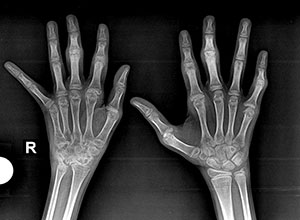Juvenile idiopathic arthritis (JIA)
Other diagnoses:
Definition
Juvenile idiopathic arthritis (JIA) – which causes joint inflammation for at least six weeks in children 16 years old or younger – is the most common type of childhood arthritis. In most cases, symptoms of juvenile idiopathic arthritis may fade after several months or years.
Juvenile idiopathic arthritis can be complicated. There are several types of juvenile idiopathic arthritis, classified based on the joints affected, symptoms and test results.
Treatment of juvenile idiopathic arthritis focuses on preserving physical activity to maintain full joint movement and strength, preventing damage and controlling pain.
Symptoms
If you're a parent or caretaker, watch for signs and symptoms of juvenile idiopathic arthritis, particularly in young children.
Symptoms depend upon the category of JIA, and the main categories of JIA are:
- Pauciarticular JIA. This affects four or fewer joints – typically larger joints, such as the knees. This is the most common form of JIA.
- Polyarticular JIA. This affects five or more joints – typically small joints, such as those in the hands and feet. Polyarticular JIA often affects the same joint on both sides of a child's body.
- Systemic JIA. Also known as Still's disease, systemic JIA affects many areas of the body, including joints and internal organs. This is the least common form of JIA.
Signs and symptoms of juvenile idiopathic arthritis may include:
- Joint swelling, with pain and stiffness. This may be more pronounced in the morning or after a nap. Commonly it affects the knees and the joints in the hands and feet. Children may complain of pain, or you might notice them limping.
- Fever and rash. These can be associated with many medical conditions, but if they're persistent, they may signal systemic JIA. Fever and rash caused by systemic JIA may appear and disappear quickly.
- Swelling of lymph nodes. This sign may occur in children with systemic JIA.
- Eye inflammation. This problem, which occurs mostly in children with pauciarticular JIA, initially produces no signs or symptoms in most of those affected. Routine eye examinations are recommended because eye inflammation may result in blindness.
Like other forms of arthritis, JIA is characterized by times when symptoms are present (flares) and times when symptoms disappear (remissions).
Causes
Doctors believe that juvenile idiopathic arthritis is an autoimmune disorder. This means that the body's immune system attacks its own cells and tissues. It's unknown why this happens, but both heredity and environment seem to play a role.
It may be that a virus or bacterium triggers the development of juvenile idiopathic arthritis in children with certain genetic profiles. These genetic profiles are detected in some children with juvenile idiopathic arthritis and are considered genetic markers for juvenile idiopathic arthritis. However, not all children with the markers develop juvenile idiopathic arthritis, and children without the markers can develop the condition.
Source: Mayoclinic.com




